Next Generation Italia, here is the draft of the Pnrr (National Recovery and Resilience Plan)
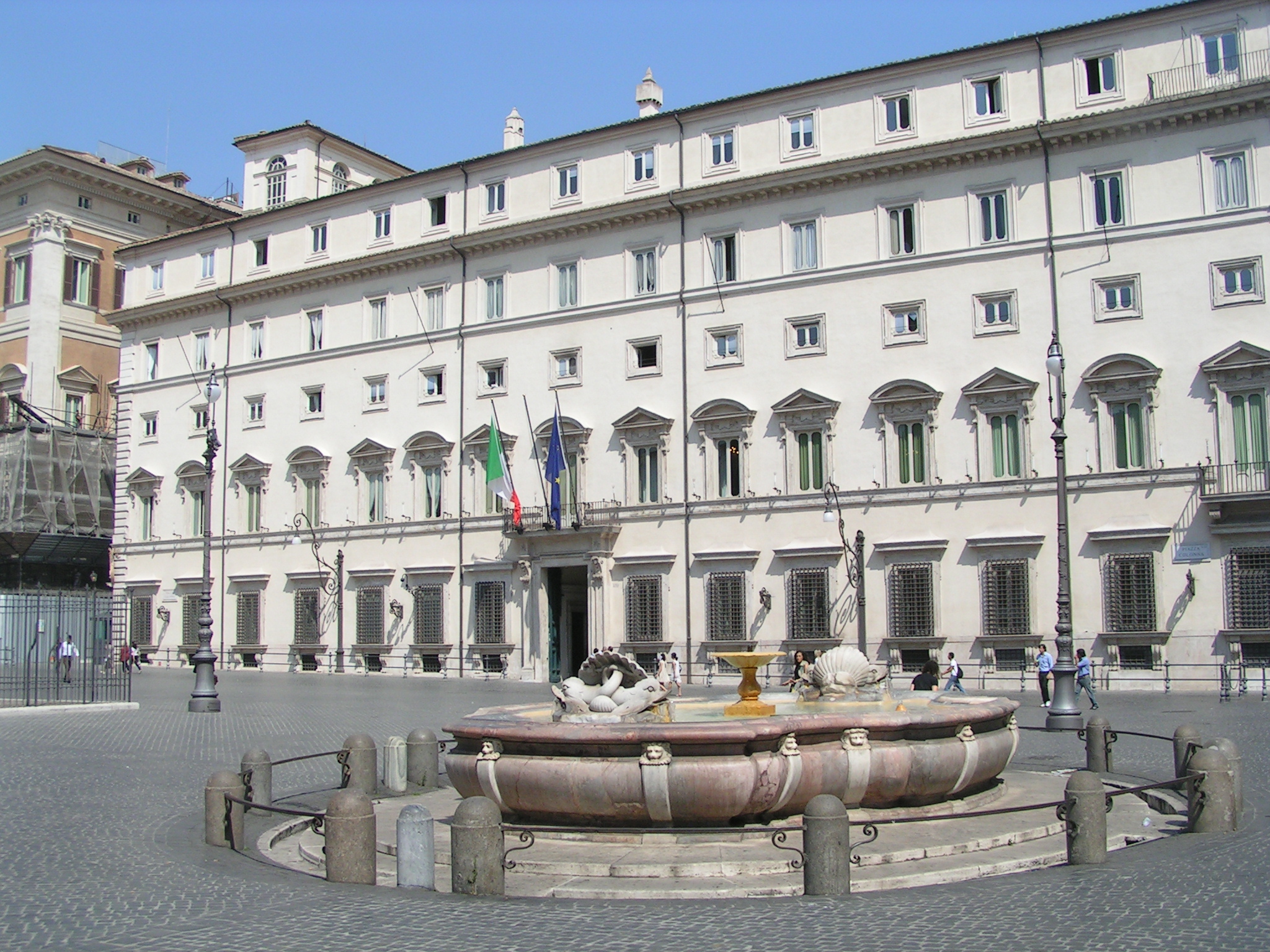
What does the draft of the Pnrr (National Recovery and Resilience Plan) foresee on digitization, innovation, sustainable mobility and broadband
According to the draft of the Recovery plan, a text on which the CDM has not yet given the go-ahead – the government will allocate for the six macro-areas of the National Recovery and Resilience Plan amount to 196 billion.
48.7 billion will be allocated to digitization and innovation, 74.3 billion will go to the “green revolution and ecological transition” area, and 27.7 billion to the infrastructure sector for sustainable mobility.
According to the draft, the “education and research” chapter can count on 19.2 billion, the one on gender equality on 17.1 billion.
Finally, the healthcare area will count on 9 billion.
Here are all the details on the part concerning infrastructure and innovation.
The intervention on mobility infrastructures envisaged in the Pnrr (National Recovery and Resilience Plan) has "ambitious objectives in terms of connectivity, safety, decarbonisation, digitalisation and sustainability of transport, in compliance with the principle of" do not significant harm " which excludes from European funding infrastructure investments that cause negative effects on the environment ".
This is what we read in the draft of the PNRR being examined by the Council of Ministers today. The infrastructural mission aims to complete “by 2026, the final year of Next Generation Eu , a first and significant step in a longer-term path towards the creation of a modern, digitized and environmentally sustainable infrastructure system.
By adding resources to existing projects and accelerating them, as well as introducing new ones, the aim will be to create and complete works that are part of European infrastructure projects or that fill gaps that have hitherto penalized the economic development of the country and, in particular, of the Mezzogiorno and delle Isole ”, adds the text.
Interventions are planned to “speed up and increase the capacity of rail transport for passengers and goods, along the priority axes of the North-South and East-West country, to favor the connectivity of the territory and the passage of traffic from road to rail. In particular, in the north of the country the Milan-Venice, Verona-Brenner, Liguria-Alps and Turin-Lyon railway lines will be strengthened, improving connections with the ports of Genoa and Trieste; in the center of the country two East-West axes will be strengthened (Rome-Pescara and Orte-Falconara), significantly reducing travel times and increasing capacities ”, explains the draft.
Finally, “High-speed trains will be extended to the South along the Naples-Bari and Salerno-Reggio-Calabria lines, also speeding up the diagonal connection from Salerno to Taranto and the Palermo-Catania-Messina line. In addition, safety measures, contrast and adaptation to climate change and digitalization of the road network are planned, which will include a strong component of technological modernization, through a digital and advanced monitoring system, which allows to reduce the risks of instability and seismic. the risks of accidents, and to make savings on future maintenance costs ".
And again the draft of the PNRR announces "a series of interventions relating to the logistics sector and in particular to the maritime system (…) to improve the competitiveness of Italian ports" with "the resolution of the" last mile ". Due to the inefficiencies of the sector, our companies pay an extra cost of logistics 11% higher than the European average ”, specifies the draft.
+++
THE DRAFT OF THE NATIONAL RECOVERY AND RESILIENCE PLAN
+++
2.1 Digitization, innovation, competitiveness and culture
The need to digitize the country is pervasive, as well underlined by the policy act formulated by Parliament. In the European comparison, Italy suffers a considerable delay in the digitization and modernization processes, well highlighted by the Digital Economy and Society Index (DESI; Figure 2.1.1): Italy is in the last places, ahead only of Romania, Greece and Bulgaria .
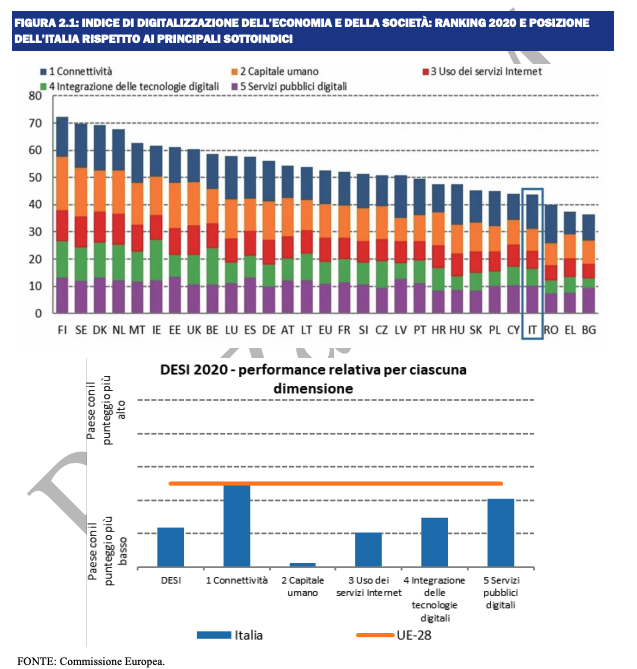
For this reason, a mission that sets itself the objective – as necessary as it is ambitious – of the digital transformation of the country, thanks to which a real structural change is triggered, is fundamental.
Digitization affects all six missions transversally, albeit in different ways.
It concerns the school in its educational programs, in the skills of teachers and students, in its administrative functions, in its buildings (see also mission 2 and 4).
It concerns health in its hospital infrastructures, in medical devices, in the skills and updating of staff, in order to guarantee the best level of public health for all citizens (see also mission 5 and 6).
It concerns the continuous and necessary technological updating in agriculture, industrial processes and the tertiary sector. In other words, digitization concerns the production fabric as a whole which can obtain significant economic advantages from new technologies both in terms of competitiveness and of better and more efficient use of resources, also being a decisive element in the protection of the territory, in monitoring infrastructures. and in the safety of large transport networks (see also missions 2 and 3).
Finally, it concerns the public administration in a widespread manner with important repercussions on technological equipment, on human and infrastructural capital, on its organization and on the methods of providing services to citizens. The achievement of digital growth and PA modernization objectives is a key to relaunching the country system. In this context, the transition to the cloud – the "cloud" that stores, makes available and potentially analyzes the digital data of billions of devices on the network – today represents the most important challenge for the digitization of the country, as it constitutes the technological substrate that enables the development and use of new technologies such as artificial intelligence.
The development of a national cloud will take place in parallel and in synergy with the European GAIA-X project, promoted by Germany and France and in which Italy intends to play a leading role. GAIA-X aims to create a European standardization forum to define the operating rules of cloud services from the control of the data processed and stored on the infrastructure, in line with the principle of "digital strategic autonomy" to the full decentralization of data thanks to latest technologies available (multi-edge, multi-cloud or edge-to-cloud).
The mission "Digitization, innovation, competitiveness and culture" revolves around two main axes: the digitization of the public sector and the integration of new technologies by the private sector and takes the form of three lines of action:
⮚ Digitization, innovation and IT security in the PA
⮚ Innovation, competitiveness, 4.0 digitization and internationalization
⮚ Culture and Tourism
These three lines of action will be accompanied by a series of reforms that will give a strong boost to simplification and efficiency in the relationship between citizens and public administration, removing obstacles that damage both the life of the citizen in the use of basic services and investments, especially with regard to infrastructure projects. These reforms can be divided into the following guidelines:
⮚ Public Administration: strengthening of the human capital of the PA, adaptation of its organization and working methods to fully implement the digital transformation, administrative simplification.
⮚ Tax: national plan to create a “cashless community”, that is, a community more prepared and attentive to digital payment.
⮚ Enterprises and production system: simplification and facilitation of the business development and creation process and support for internationalization; the regulation on business crisis and insolvency.
As for the investments in which the three components of the mission Digitization, innovation, competitiveness and culture are realized, these are distributed over 13 projects, for a total amount of resources equal to 48.7 billion euros.
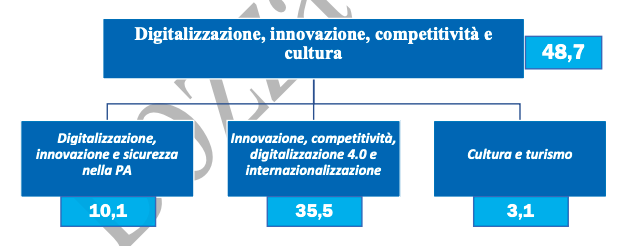
The first component – Digitization, innovation and security in the PA – aims at a radical qualitative leap in the PA, through the digital transformation of the public sector and its consequent structural reform. For this reason, the proposed interventions combine investments in new endowments and services with important interventions in the organization and in the endowment of human capital of the PA, according to a strict complementarity and an articulated reform strategy.
The actions to equip the PA with modern and digital infrastructures and services fall within the following four areas that can be considered the "vectors of digital transformation":
1. Digital infrastructures. In order to equip the PA with reliable infrastructures and accompany central administrations towards a new logic of conservation and use of data and provision of services, an efficient and secure cloud system is first of all necessary. The rationalization and consolidation of the existing digital infrastructures in a new Cloud model for the PA will allow significant savings in the cost of maintenance and updating of the data centers over the next three years. This implies investments for the development of a highly reliable infrastructure, located on the national territory for the rationalization and consolidation of the Information Processing Centers and to host the most strategic services of the central PA and green strengthening of the Data Centers. Type A, National Strategic Poles from the census of the Agency for Digital Italy6. The digital infrastructures and services of the Public Administration, in fact, are today characterized by a significant fragmentation and a strong technological delay (excluding some poles of excellence): there are about 22 thousand entities with 11 thousand data centers distributed throughout the peninsula. Of these, 95% have deficiencies in the minimum requirements for safety, reliability, processing capacity and efficiency7. Maintaining this inefficient structure means exposing a large attack surface to cybercrime and incurring an estimated maintenance expense of over 7.5 billion annually. The savings deriving from a rationalization of this infrastructure would reach 40-50% of this amount when fully operational.
2. Data and interoperability. The infrastructural equipment and the cloud are enabling technologies for the development of a sort of “country's operating system”, which makes it possible to process the large quantities of data and information indispensable for providing and managing services to citizens and businesses. The increased capacity of archiving, storing and extracting data by the individual administration, however, is not sufficient for a rational and efficient use of this information assets, in the absence of standards and tools that allow full interoperability and sharing of information between public administrations. Therefore, to effectively and completely implement the once-only principle, it is necessary to make the databases interoperable and make them accessible through an API catalog that allows central and peripheral administrations, according to various authorization levels, to draw on cloud data, process them and provide services to citizens and businesses, who will thus be able to provide information "once only" to the Administration.
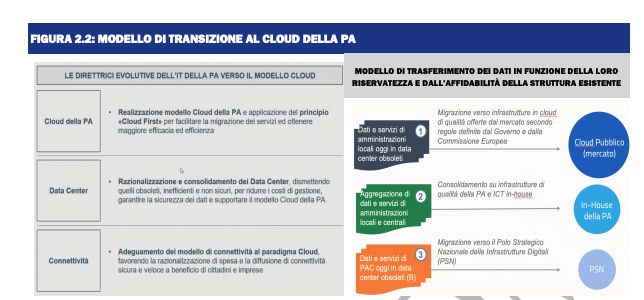
Note: Data that does not present particular criticalities can be stored in market clouds, called public, (such as those commonly offered through subscription services (Apple, Google, Fastweb, Tim) but in any case according to rules that guarantee their integrity. For data that have confidentiality profiles, greater security measures are required and therefore "private" clouds are used, for the exclusive use of the PA, which may result from the aggregation of existing ones, when of high quality, or consist of a National Strategic Pole created specifically to collect data currently stored in unsafe facilities.
3. Services and platforms. The fundamental principle on which this innovative “country's operating system” is based is that of exploiting digital technologies at the service of citizens and businesses; it therefore requires the design, development and monitoring, through the use of public sector data, of policies and services focused on the needs of users who, in order to use them, must be “enabled” to use digital services. Therefore, it is necessary to develop and disseminate enabling platforms such as: digital identity, electronic signature, digital payment tools, electronic health records, etc., implementing their use through common standards. At the same time, the aim is to promote basic and advanced digital literacy of citizens and businesses through the setting up and strengthening of the Network of Digital Facilitation Services in the territories and the creation of Houses of innovation and digital culture. In these structures, training, experimentation and orientation courses will be activated, which are essential to strengthen the abilities of citizens and businesses to use information technologies and take advantage of digital public services. The professional involvement of approximately 4,500 young people adhering to the Digital Civil Service, which will be launched for this purpose, will help this action to spread skills and fight digital exclusion.
4. Cyber security. The security of the country's digital ecosystem, with specific attention to ICT assets that support the essential functions and services of the State, constitutes the necessary premise for the growth of the community and a fundamental element for the development of technologies in strategic fields such as those of "Cloud computing", Cyber security, Technological scrutiny, Artificial Intelligence. The National Cyber Security Perimeter (PSNC), together with the implementation of the NIS Directive and the AGID Minimum Measures, are far-reaching reform projects, aimed at ensuring an integrated and univocal approach of the Italian Public Administration to the cyber threat over time and will to improve the resilience capacity of the country system. They will also ensure the reduction of the attack surface, through the rationalization of data centers and the elimination of obsolete ones. For the research and development of national cyber security technological solutions – to be used within the PSNC and the NIS – a Cybersecurity development and research center will also be established, which will operate through the establishment of Public-Private Partnerships (with national champions and universities) and the launch of spin-offs / startups. The initiative will constitute an important development driver for the sector economy, will ensure greater attractiveness of Italy in terms of skills, will act as an aggregator and multiplier of highly specialized experiences, avoiding duplication of effort and rather optimizing employment. of resources. The positive effects will be high in terms of effectiveness, efficiency and competitiveness of the country, which will thus be able to contribute to the achievement of national and European strategic autonomy. The center will be the natural national interlocutor for the European Center for industrial, technological and research development in the field of cyber security and the related network of national coordination centers, and will contribute to increasing the planning capacities of the various national actors, facilitating the their participation in European programs.
In synergy with the infrastructural and digital transformation of the PA, a strategic innovation project of the PA is developed, which in turn can be divided into three lines of intervention:
1. A competent PA. Strengthening and enhancement of human capital through targeted policies for recruiting personnel with the necessary skills and training for the staff currently employed.
2. A simple PA, connected and at the service of citizens. Simplification of administrative procedures, digitization of processes and speeding up of procedures, with direct and measurable impacts on services to citizens and businesses and positive effects on the productivity of the private sector and the attractiveness of the country.
3. A capable PA. Evolution towards new organizational models of work through the creation of spaces equipped for co-working and agile work (smart-working) within the Territorial Poles and the promotion of agile forms of work.
Alongside these macro projects there are two significant initiatives, the first to accompany the justice reform, the second to encourage digital payments.
1. Organizational innovation of Justice and introduction of the figure of the judicial assistant: Based on three interventions 1) introduction of new organizational positions; 2) fixed-term hiring plan to acquire technical administrative skills to support the planning, design, management and control of Digitization Projects, Judicial Construction (see Mission 2) and Civil and Criminal Process Reform; 3) staff training and retraining.
2. Spread of the use of digital technologies and payments in the population. Incentive mechanisms for the use of electronic means of payment for both consumers and merchants. The intervention will entail a structural change aimed on the one hand to favor the emergence of the tax base and on the other to bring the rate of electronic payments in Italy to the level of that of other European countries within three years.
The Public Administration Digitization Plan intends to address the structural problems that have so far slowed down this process. The "Simplifications" decree (decree-law 16 July 2020, n. 76, converted by law 11 September 2020, n. 120) has already introduced some rules aimed at supporting the digitalization of the PA and favoring faster processes:
– the expansion of the diffusion of public services on the net, facilitating and simplifying their access by citizens and businesses (digital domicile, simplification of notification and electronic communication of documents in civil, criminal, administrative, accounting and extrajudicial matters; art. 28).
– the simplification of procedures, improvement of efficiency and reduction of numerous costs for the Public Administration, for example the introduction of a single digital platform for notifications of acts and provisions of the PA to citizens and businesses (art.26) or measures for the simplification and dissemination of the advanced electronic signature and digital identity for access to banking services (Article 27).
– the right to innovate for companies that will benefit from simplified procedures for experimenting with innovative projects. In this context, in particular, simplification measures are envisaged for the granting of authorizations for the start-up of innovative projects for companies, universities, research centers and university start-ups (Article 36).
Additional actions that will be implemented to determine an acceleration of IT spending, which affect all the main dimensions (people, processes and tools) of strengthening administrative capacity as identified by recent studies on the subject (see OECD (2020) , Strengthening Governance of EU Funds under Cohesion Policy: Administrative Capacity Building Roadmaps) can be summarized as follows:
– IT technical assistance / task force – Start a process of strengthening administrations, accompanying them through sectorial technical expertise (engineers, IT professionals …) and / or real task forces, starting from the choice of the IT solution. But also in the phases of supplier selection (award procedure), maintaining the supervision to guarantee the absence of conflicts of interest of the personnel involved in the technical support assistance;
– IT catalog / construction site initiatives – Launch initiatives that can be quickly created, also through the definition of a national catalog of IT services, which includes all the administrative tools necessary to give you prompt activation. To aim, in general, at solutions that can guarantee the achievement of the objectives by reducing design times as much as possible;
– National IT network – Start the creation of a "National IT Network", as an exclusive institutional place that sees the direct and participatory involvement, on operational and technical issues, of all institutional stakeholders (central administrations, representation of Regions and Local Authorities) but also of the economic partnership. The National Network, through a continuous and structured administrative and technical comparison between the representatives
designated by the administrations, will constitute a stable meeting place for the ongoing implementation comparison of IT initiatives to identify and overcome implementation criticalities, guarantee the detection and exchange of good practices and to contribute to representing the intervention needs, including legislative ones, to be bring to the attention of the Government for a continuous stimulus for simplification in IT matters;
– simplified costs – Simplify the spending phases, activating standard methods for defining the cost of IT solutions (standard unit costs). Therefore, accelerating the reporting processes in all cases of co-financing of initiatives with EU funds (PNRR, Structural Funds…).
The second component – Innovation, competitiveness, digitalization 4.0 and internationalization – aims to facilitate the acceleration of the digital transition of businesses, especially SMEs. As Parliament also points out in its indications, the development of a fast and ultra-fast digital connection network is essential to spread innovation and new services. In fact, the connection is an “enabling technology” to take advantage of various “4.0 technologies” – such as sensors, Internet of Things, and three-dimensional printers – which require fast connections and low latency times. Ultra-fast broadband networks are a General Purpose Technology, capable of triggering large-scale productivity and growth gains in all sectors of the economy.
However, Italy still shows a significant digitization gap: according to the latest DESI index on connectivity it ranks 17th on connectivity and the integration of digital technologies at 22nd out of 28 EU countries. The coverage rate of Italian households with ultra-fast networks is 24%, compared to an EU28 average of 60%, while the activation of subscriptions is 9%, compared to an EU28 average of 20%.
Among the causes of this delay there are some demand factors, including a lower incidence of the youth population, digital skills of the population below the European average, a low willingness to pay for faster connections and marked territorial disparities in the levels of development. On the supply side, there have been delays in laying fiber optic cables and in providing wholesale access to new generation infrastructures, which have only been partially overcome in recent years.
The Italian government approved in 2015 the national strategy for ultra-broadband, capable of mobilizing over 12 billion public and private resources, in order to reduce the infrastructure gap through the integrated development of a fixed and mobile TLC network, based on on "future proof" fiber technology. Starting from 2015, thanks to the approval of the Italian strategy on BUL, investments in the fixed network have undergone a significant acceleration, equal to 23% between 2015 and 2018.
Therefore, the PNRR intends to promote a "fiber project" that avoids the risk of duplication in the grounding of the network – which is part of the national strategic infrastructures – while guaranteeing full competition in the supply of services also through appropriate forms of separation wholesale network management activities from those of retail services.
This component is structured around four main interventions:
1. Transition 4.0: Provides incentives to facilitate the digital and green transition. These are two main interventions that replace the previous regulation: a) 2021/2026 tax credit for investments in capital goods (also replaces depreciation and super-depreciation) and b) Upgrading of machinery for which companies can claim a tax benefit (New Sabatini).
2. The enhancement of the optional "Patent Box" taxation regime for business income deriving from the use of copyrighted software, industrial patents, designs and models, as well as legally protectable processes, formulas and information relating to experiences acquired in the industrial, commercial or scientific fields.
3. Digital agriculture, based on cloud and (near) real time technologies, with blockchain systems and decentralized input / output services, which will allow “talks” between administrations and between them and farms throughout the national territory. The initiative will make it possible to strengthen the capacity for analysis, enhancing the information assets, with the development and adoption of models for the evaluation of agricultural policies.
4. Publishing 5.0: A publishing plan is envisaged that has as its objective the modernization of the sector and specific incentives for the digital transition of companies in the sector. New professional skills relevant for the technological and digital transformation of companies.
5. Broadband, 5G and satellite monitoring: Interventions are planned to reduce the digital divide, favoring the achievement of the European objectives of the Gigabit society. The main interventions include the completion of the Ultra Wide Band project (in particular in gray areas) and the fiber optic coverage in public realities considered as a priority (schools, hospitals, natural parks, museums and archaeological sites, extra-urban communication routes) . Interventions are also planned for the promotion of 5G and 5G Safety services. In addition, the Extraordinary Plan for the space economy provides for the launch of a satellite constellation for monitoring the Earth (optical and via radar) at high resolution with the related construction of the ground infrastructure for controlling the constellation and the establishment of an institute. for environmental monitoring and defense of the territory, through AI systems and high speed computing. Furthermore, in a complementary manner with what has been described above, interventions are planned in the field of tracking (Galileo mirror) and low-latency satellite telecommunications for institutional and government services (GovSatCom), also implemented in public-private partnership.
6. Innovation and technology (microprocessors)
7. The internationalization of companies, through:
the. The refinancing and remodeling of the Fund 394/81 managed by SIMEST – support for the internationalization of companies
ii. The internationalization and digitization of the Fair Bodies
iii. Strengthening the Pact for exports
In the third component, “Culture and Tourism”, interventions are concentrated in two of the sectors most affected by the pandemic that need specific support to accompany their recovery and strengthen their resilience for the future. The crisis following the spread of the Covid 19 epidemic has hit both sectors hard due to both the closure of museums and other cultural institutes and places to the public and, more generally, due to the blocking of tourist movements. According to the estimates of the World Tourism Organization
of the United Nations, international tourist arrivals in Europe fell by 58% between January and March 2020. In Italy, according to Istat estimates, the first wave of Covid-19 caused the loss of about one fifth of tourist presences expected for the whole of 2020 in the quarter March-May; in perspective, the renewed impetus of the contagion risks causing further damage to tourist presences and, consequently, to the turnover of tourism businesses in the winter season.
Similarly, during the spring lockdown phase, museums and artistic heritage recorded an estimated loss of around € 80 million, cinema recorded a box office loss of around € 120 million and music – in particular the component linked to live activity – suffered a contraction in revenues estimated at around 350 million euros.
With this component it is confirmed as a priority for Italy to ensure the stability of the cultural demand index in the short term to increase it in the medium term (before the outbreak of the pandemic, the expenditure of Italian families alone for recreation and culture stood at 6.7% , against a European average of 8.7%), at the same time relaunching the use – including digital – of places of tourism and culture.
Italy ranks first in Europe in terms of the number of cultural enterprises (15% of the EU-27 total in 2017, according to Eurostat), but is third in terms of turnover and added value, behind Germany and France. Many cultural institutions do not have digital infrastructures or lack skills: only 16% of Italian museums have staff dedicated to ICT and digital activities; of the 460 state museums, 43.7% have their own website while those that have at least one social media are 66% and there are still great differences at the territorial level. This backwardness contributes to the insufficient valorisation and low usability of our immense cultural heritage.
One of the strategic interventions of this component will contribute to the strategic use of digital by cultural institutions. With the Cultural Heritage for Next Generation program we want to start a deep digitization of cultural heritage (with the use of advanced digital technologies we will proceed to the completion of computerized archives and catalogs), to promote widespread and inclusive access to a wide range of subjects : citizens, students, researchers, cultural and creative industries, etc ..
Investments in the regeneration of cultural heritage produce a wide range of economic, social and environmental benefits: they strengthen the cultural value of the site, increase the attractiveness of places and contribute to their economic and social prosperity. Investment in cultural heritage guarantees good profitability and is a significant generator of tax revenues deriving directly from the economic activities of sectors connected to cultural heritage and, indirectly, thanks to new projects stimulated by redevelopment interventions.
A recent ESPON report estimates the impact of cultural heritage on the economy in 11 European countries: 2.1% of total employment and 1.6% of total Added Value (excluding financial and insurance activities) as well as 549,003 jobs. The European Court of Auditors stressed that EU investments in sites of cultural interest deserve greater attention and coordination and that the prevalence of economic objectives prevents sufficient attention to be paid to the sustainability of cultural sites. The investments themselves are a fundamental step in the country's transition process towards the objectives of the European Green Deal because they can ensure a concrete contribution in favor of climate action and in the creation of regenerative models of cities, territories and landscapes according to the principles of 'circular economy, reducing waste and attributing new values to resources, thereby supporting a just and inclusive transition towards a healthier, greener and fairer society and economy.
This component pursues the objective of enhancing quality professional tourism training, also through the creation of a national structure for the training of personnel involved in tourism activities, as well as through the revision of training programs and the definition of homogeneous and shared professional profiles. on the entire national territory.
It also pursues the objective of protecting and enhancing the national cultural heritage, maximizing its economic, social and cultural benefits for local communities and guaranteeing its sustainability also from an environmental point of view. Strategic interventions are contemplated on major tourist-cultural attractions, to encourage the increase in cultural demand for various attractors of national strategic importance (including: the Venice Biennale, the European Library of Cultural Information in Milan, the Old Port of Trieste, the of the Genoese forts, the Bourbon parks in Campania, the Apulian coastal park of culture, tourism and the environment, the Auditorium that will rise at the former tobacco factory in Palermo), through the implementation of interventions for the protection, conservation, strengthening and qualification of services connected with the use and promotion of goods.
In addition to providing for the redevelopment of public buildings in a state of neglect or underuse, always using green building techniques, action will be taken on the protection and enhancement of the historical, architectural and artistic heritage, which involves the recovery and enhancement of historic centers of cultural heritage (museums, archaeological parks, monumental complexes) of historical parks and gardens. Particular attention will be dedicated to the recovery of sites of inestimable landscape and cultural value also in the internal areas of the country, often neglected or little known because they are outside the traditional tourist circuits. We will also intervene on small historical and rural villages, with specific and targeted actions on the historical – cultural and religious heritage (abbeys, rural churches and sanctuaries). In this way, the needs of the large Italian community residing abroad will also be met, to foster and nourish the strong bond with our country and its small villages, natural destination of their tourist and cultural demand, favoring a "tourism of origins ".
We will act in compliance with the identity and typical characteristics of the various local contexts also through a new model of sustainable tourism capable of enhancing the resources of the territories in an integrated way and favoring the seasonal adjustment of tourist demand. And these actions will help the relaunch of commercial activities, the enhancement of traditional agri-food and artisanal production linked to local knowledge and techniques.
The interventions also provide for greater cooperation between public, private, citizen and community actors both in terms of sponsorship incentives and through forms of multilevel governance, in line with the "Faro Convention" on the value of cultural heritage for society, and with the European Framework for Action for Cultural Heritage, which calls for the promotion of integrated and participatory approaches in order to generate benefits in the four pillars of sustainable development: the economy, cultural diversity, society and the environment.
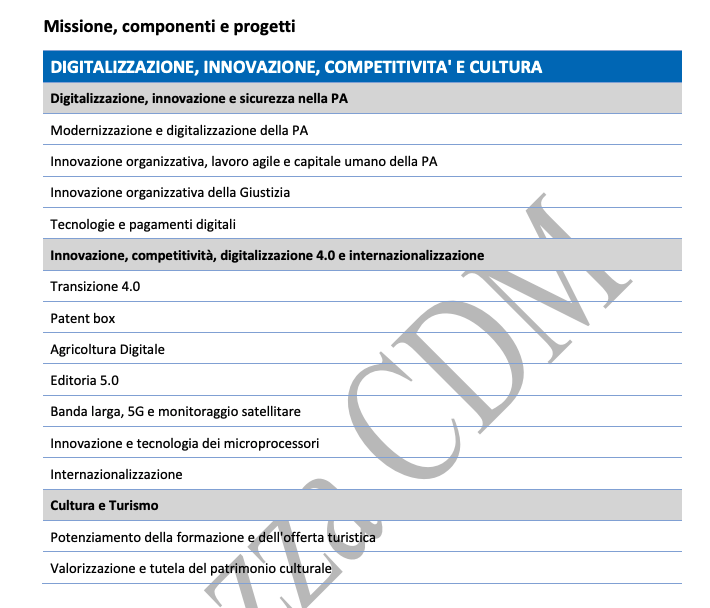
2.2 Green revolution and ecological transition
With the mission "Green revolution and ecological transition", Italy, which has also made significant progress in reducing greenhouse gas emissions, increasing the share of energy satisfied with renewable sources and improving energy efficiency, is intensifying its commitment to meet the new and more ambitious European targets set by the European Green Deal, with an emissions reduction target of 55% by 2030.
Achieving climate neutrality by 2050 requires investment and a wide range of enabling reforms. In particular, the decarbonization scenario that would lead Italy to climate neutrality by 2050 highlights an emission gap that must be closed through three main types of actions: (1) a substantial reduction in energy demand (especially in the residential / commercial sector and in the transport sector); (2) a further change in the energy mix in favor of renewables, together with an extensive electrification of end uses and the production of hydrogen; (3) an increase in CO2 removals from forest surfaces and soils.
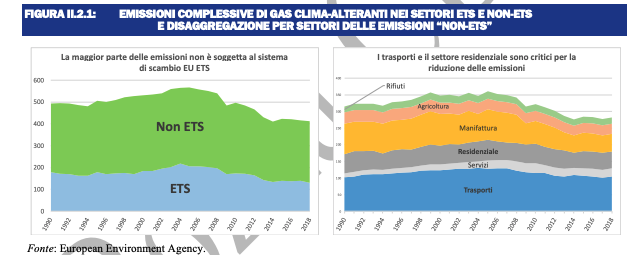
The mission takes the form of 4 lines of action (components) as regards investments:
⮚ Green business and circular economy
⮚ Energy transition and sustainable local mobility
⮚ Energy efficiency and building renovation
⮚ Protection and enhancement of the territory and the water resource
The investment actions will be accompanied by some specific reforms aimed at favoring the energy transition and ecological change:
⮚ The definition of a national strategy on the circular economy, which is based on a regulatory reform intervention, called "Circularity and traceability": aimed at implementing the European action plan for the circular economy and to regulate organization and operation of the waste traceability system. Regulatory measures are also contemplated to promote the repairability, durability, and forms of reuse / recovery of products, in particular those that fall into strategic value chains or identified on the basis of environmental impact and their potential for circularity. Among other things, the strategy envisages the creation of a national technological hub and territorial competence centers for the circular economy to support the production system.
The investments in which the four components of the Green Revolution and Ecological Transition mission materialize are spread over 13 projects for a total amount of resources equal to 74.3 billion euros.
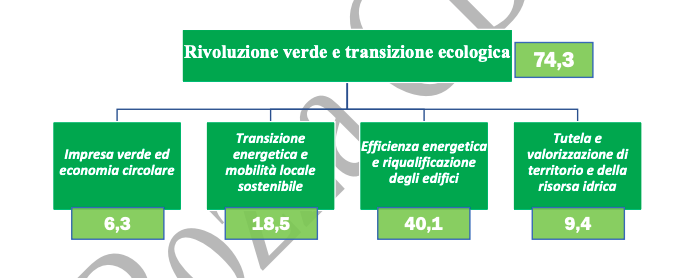
Overall, these interventions should contribute to reducing CO2 emissions by approximately XXton over the next 6 years (Table M2.1 estimates being finalized).

The first component "Green business and circular economy", has as its priority objectives the promotion of environmental sustainability in the agricultural supply chain, support for innovative decarbonisation projects through circular economy processes, as well as the definition of a national plan for the economy circular. In the latter area, Italy is in line with the 2020 European objectives in terms of reuse and recycling of materials: in 2017 the circular use rate of materials was 17.7%, above the European average, and in 2018 the recycling rate stood at 49.8%. A further legislative push in this area comes from the recent transposition of the circular economy package (Directives 2018/849, 850, 851, 852), in which there are targets for urban waste (recycling of 55% by 2025, of 65 % by 2035), packaging waste (70% recycled by 2030) and for the use of landfills maximum threshold of 10% of municipal waste with landfill disposal by 2035 (in 2018 the use of landfills has affected 22% of the municipal waste produced).
To achieve these objectives, in addition to strengthening the regulatory framework through targeted reform measures, two lines of action are envisaged:
1. The first line of action “Sustainable agriculture” includes initiatives for the competitiveness, energy requalification and logistic capacity of the Italian agricultural sector. In particular, the interventions aim at energy efficiency and thermal insulation / insulation of buildings used for productive use in the agricultural and livestock sector, the latter responsible for about 50% of climate-altering gas emissions. Finally, we intend to support a plan for the logistics of the agricultural sector, which consists of contributions to companies to lower the environmental impact of the transport system, improve the storage capacity of agricultural raw materials, the logistical capacity of wholesale markets. and to express the potential in terms of exports of small and medium-sized Italian agri-food companies.
2. The second line of action "Circular economy and waste management" is focused on three main interventions: a) the reduction of the plant engineering gap in the recycling chain, which is a main critical issue in many regions of the country, through modernization existing plants and the construction of new plants for the mechanical biological treatment (TMB) of waste; b) support for initiatives to obtain “circular” chemicals and fuels from plastic and urban waste; c) support for innovative decarbonisation projects.
The second component "Energy transition and sustainable local mobility" intervenes first of all on the production and distribution of energy, favoring the use of renewable sources and providing the necessary infrastructures for their integration into the national electricity system and the infrastructures to power electric vehicles and exploitation of liquid hydrogen. Italy is progressing towards full climate neutrality in line with the objectives previously established by the National Energy and Climate Plan (PNIEC), but must accelerate and intensify its commitment to reducing emissions to meet the new and more ambitious European targets set from the European Green Deal. To this end, the component intervenes through an action to decarbonise transport, with particular attention to the renewal of the rolling stock of local authorities and, more generally, to the modernization of the national car fleet which is among the oldest in the European Union. . These structural changes to our production and energy system will also help reduce local pollution: 3.3 percent of the Italian population lives in areas where the limits of pollutants (particulates and nitrogen oxides) present in the air are exceeded. by European directives.
To achieve these objectives, the component includes the following lines of action:
1. The implementation of measures to promote the growth of renewable energy production and the use of hydrogen and support the supply chain through: a) support for the creation of a pipeline of new renewable greenfield projects with authorization procedures within a certain time frame; b) financial support through grants to support the development of floating PV and offshore wind projects; c) financial support for grid parity plants; d) the promotion of the collective self-production of renewable electricity, encouraging the establishment of energy communities and individual self-consumption, in the latter case overcoming the so-called “exchange on the spot” regime; e) support for the transition from biogas for electrical use to biomethane for transport; f) investments in the production of hydrogen in brownfield and electrolysis sites, the creation of refueling stations and research and development projects for end-use hydrogen applications.
2. The introduction of measures for sustainable mobility and to improve urban planning. These include: a) the strengthening of network infrastructures and the promotion of storage; b) the creation of smart grids; c) the installation of electric charging and vehicle-to-grid (V2G) systems; d) new experiments for digital services to support urban planning; e) the National Cycle Paths Plan; f) the reduction of the infrastructural and instrumental gap in the sector of local public transport, fixed installations and local public transport, with particular attention to the renewal of the bus fleet, the rolling stock and the fleet of national TPL vessels.
3. An overall reform implemented through the adoption of the “air quality” plan, aimed at reducing the emissions of the target pollutants of directive 2016/2284 expressed in tonnes / y and at reducing climate-altering emissions. The plan includes:
⮚ the adoption of a national air pollution control program (pursuant to EU Directive 2016/2284);
⮚ implementation of DL Clima with 4 implementing decrees;
⮚ reform program Regions of the Po basin;
⮚ implementation of legislative and financial legislation with other regional agreements;
⮚ PNIEC implementation on reporting.
The third component "Energy efficiency and redevelopment of buildings", intercepts a very significant dimension for the reduction of CO2 emissions: the reduction of energy consumption of buildings that generate more than a third of total consumption in Italy, as well as the adaptation anti-seismic of the same. In fact, most of the country's 14.5 million buildings were built in times prior to the current regulations related to energy efficiency; moreover, Italy is particularly exposed to risks linked to seismic risk, which require a widespread diffusion of prevention interventions.
To achieve these objectives, the main investments and incentives are developed in two lines of action:
1. The implementation of a plan to improve the efficiency of public buildings which includes, in particular: a) the structural rehabilitation of school buildings and the construction of new schools by replacing buildings; b) the restructuring and modernization of hospital structures, with particular reference to the offices of the Emergency and Acceptance Departments; c) the requalification of the housing stock of national public housing; d) the efficiency and redevelopment of the judicial towns located in various Italian cities; e) energy efficiency and redevelopment of public buildings in metropolitan areas, including for social services; f) a specific program of interventions aimed at the municipalities of the national territory and aimed at reducing the energy consumption of the buildings they own.
2. The strengthening of measures to support the efficiency of private construction. In particular, the extension of the building superbonus for energy efficiency and anti-seismic adaptation of private homes is envisaged, with which a tax deduction equal to 110% of the costs incurred for the interventions is recognized, which can be used as tax compensation or convertible in transferable tax credit.
The fourth component "Protection and enhancement of the territory and of the water resource" has the objective of strengthening the interventions to mitigate hydrogeological instability and increase resilience to extreme climatic events; to promote the sustainable use (civil and irrigation) of water resources and the quality of inland and marine waters; as well as to improve the adaptation to climate change of the territory by contributing to the decarbonisation process through forestation and energy efficiency interventions. Investments in water infrastructures, in recent years, have been insufficient, causing high levels of losses and persistent risks of scarcity of the water resource; at the same time, four infringement procedures are opened against Italy for the irregular collection and treatment of wastewater in 987 urban agglomerations throughout the national territory. Italy is also particularly vulnerable to hydrogeological and seismic events: over 90% of Italian municipalities face a high risk of landslides and floods and therefore require continuous investments in the prevention of these risks. To fill the gaps in the management of the water cycle, interventions are planned aimed at digitizing and making the primary and secondary water network safe, at reducing water waste in the supply, distribution and irrigation networks, with the aim of guaranteeing the availability of water for all uses, the adaptation of purification systems to European directives, the reuse of purified water and the management of waste in port waters, and the protection of the territory from floods through forestry interventions, sustainable management in agriculture and adaptation to climate change in municipalities.
In support of investment projects, an overall reform action is proposed which consists of a process of strengthening the governance of the integrated water service, with the aim of entrusting the service to integrated managers in areas of the country where this is not yet occurred, and the strengthening of the technical structures to support the Commissioners in the design, procurement and supervision of protection interventions against hydrogeological risk.
Finally, the reform is aimed at enhancing the design capacity of the reclamation consortia also through regional planning centers, promoting the revision and strengthening of the consortium governance model and keeping the protection of the territory and saving resources at the center of its action. water for irrigation purposes and the improvement of the sustainability of agricultural production processes.
The reform provides for rapid regulatory intervention, subsequently the completion of any implementing decree or other policy and coordination acts will be ensured, with the aim of completing the strengthening of operational capacity by 31 December 2021.
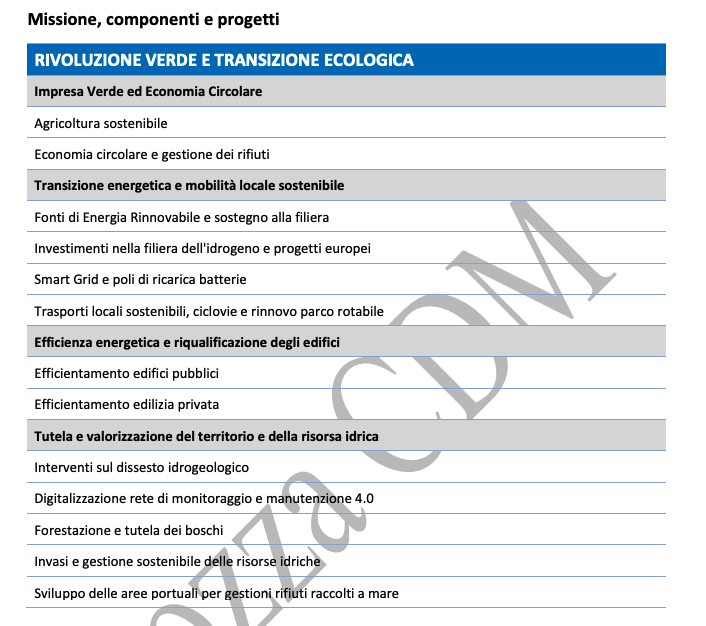
THE DRAFT OF THE NATIONAL RECOVERY AND RESILIENCE PLAN
This is a machine translation from Italian language of a post published on Start Magazine at the URL https://www.startmag.it/innovazione/next-generation-italia-ecco-la-bozza-del-pnrr-piano-nazionale-di-ripresa-e-resilienza/ on Mon, 07 Dec 2020 14:05:39 +0000.
